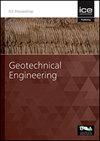不同归一化断距下逆断层剪切带形成的微观宏观分析
IF 1.7
4区 工程技术
Q3 ENGINEERING, GEOLOGICAL
Proceedings of the Institution of Civil Engineers-Geotechnical Engineering
Pub Date : 2022-12-19
DOI:10.1680/jgeen.22.00095
引用次数: 0
摘要
采用二维离散元模型研究了变密度砂土逆断层剪切带形成的工程和基础问题。用离心实验结果验证了所采用的DEM建模方法。从工程角度看,逆断层形成的剪切带由不同断隆处形成的多个断裂组成。根据断层角度的不同,这些裂缝可能会向垂壁或基底壁偏移。在1%归一化断层距(H /H)阶跃下,用W/H比值捕获变形带露头位置。研究了剪切带的微观和宏观方面,如孔隙率、配位数和剪切带局部区域内的强接触力。此外,在剪切带内发生的微观和宏观事件之间建立了联系。结果表明:在倾角小于45°的断裂中,剪切带与逆冲破裂之间形成的楔形压力对剪切区逆冲形成及微宏观参数影响显著;本文章由计算机程序翻译,如有差异,请以英文原文为准。
Micro-macro analysis of shear band formation due to reverse fault in various normalized fault throw
A two-dimensional discrete element modeling is adopted to study engineering and fundamental aspects of shear band formation in reverse faulting through sandy soils with varying densities. The employed DEM modeling methodology is verified with the experimental centrifuge result. From an engineering perspective, results show that the shear bands formed due to reverse fault consist of multiple ruptures formed at the different fault raise. These ruptures may deviate toward the hanging or footing wall depending on the faulting angle. The distortion zone outcropping location is captured by the W/H ratio at the 1% normalized fault throw (h/H) step. Various micro and macro aspects of shear banding, such as porosity, coordination number, and strong contact forces within the localized areas along the shear bands, are studied. Moreover, a link is established between the micro and macro events occurring inside the shear bands. The results show that the wedge pressure formed between the shear band and back-thrust rupture in the fault with a dip angle smaller than 45° significantly affects the back-thrust formation and micro-macro parameters in the shearing region.
求助全文
通过发布文献求助,成功后即可免费获取论文全文。
去求助
来源期刊
CiteScore
4.40
自引率
4.50%
发文量
68
审稿时长
3 months
期刊介绍:
Geotechnical Engineering provides a forum for the publication of high quality, topical and relevant technical papers covering all aspects of geotechnical research, design, construction and performance. The journal aims to be of interest to those civil, structural or geotechnical engineering practitioners wishing to develop a greater understanding of the influence of geotechnics on the built environment.

 求助内容:
求助内容: 应助结果提醒方式:
应助结果提醒方式:


